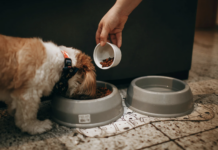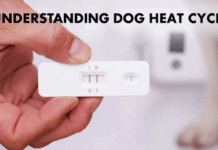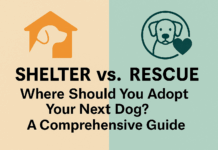Last Updated on September 30, 2024 by Dogs Vets
Bringing pets along on car rides can be a joyful experience, but it also presents unique challenges for drivers. Unrestrained pets can become a distraction, leading to unsafe driving conditions and an increased risk of accidents.
Ensuring that your pet is properly prepared for car rides keeps them safe and allows you to remain focused on the road.
Using a pet seat belt, carrier, or harness can help keep your pet secure and reduce driving distractions. Additionally, making sure your pet is comfortable and calm before setting off can prevent anxiety-driven behaviors that might interfere with your ability to drive safely. Regular breaks during long trips can also help your pet relax and further enhance safety during the journey.
Use a Pet Restraint System
One of the most important steps in preparing your pet for a car ride is ensuring that they are properly restrained. Unrestrained pets can easily move around the vehicle, creating distractions for the driver. Additionally, in the event of a sudden stop or collision, an unrestrained pet can be seriously injured or pose a risk to other passengers.
Several options are available for restraining pets, including pet seat belts, harnesses, and crates. Pet crates are particularly effective for keeping smaller animals secure, while larger dogs may benefit from a seatbelt harness. Proper restraint not only keeps your pet safe but also minimizes distractions, allowing you to focus on the road.
Get Your Pet Comfortable with Car Rides
If your pet isn’t used to car rides, it’s essential to gradually acclimate them to the experience. Start with short trips around the neighborhood to help your pet get accustomed to the motion and sounds of the vehicle. Reward them with treats or praise to create positive associations with being in the car.
Over time, you can increase the length of the trips as your pet becomes more comfortable. A calm and relaxed pet is less likely to become anxious or cause distractions during longer car rides. This training process is crucial for ensuring a smooth and safe journey.
Plan for Breaks on Long Trips
If you’re planning a long road trip with your pet, scheduling breaks is essential for both your comfort and theirs. Like people, pets need regular breaks to stretch, hydrate, and relieve themselves. Plan to stop every couple of hours to give your pet a chance to move around and take a break from being confined.
In addition to physical breaks, check your pet’s condition during these stops. Make sure they’re not showing signs of anxiety, motion sickness, or overheating, especially in hot weather. Keeping your pet comfortable during long drives helps reduce the likelihood of distracting behaviors while driving.
Keep Essentials Handy for the Ride
Before hitting the road, pack a travel kit for your pet that includes essential items such as water, a bowl, food, treats, and waste bags. If your pet is prone to anxiety, consider bringing familiar items like their favorite toy or blanket to help them feel more secure. Having these items handy ensures that your pet’s needs are met without rummaging through bags or making unnecessary stops.
Keeping your pet’s essentials within reach also allows you to focus on the road, knowing that you can easily tend to their needs during a break. A prepared driver is a safe driver, and ensuring your pet’s comfort contributes to a more focused driving experience.
Avoid Letting Your Pet Sit in the Front Seat
Allowing pets to sit in the front seat can be dangerous, especially if the airbags deploy during an accident. Even in minor collisions, airbags can cause serious injuries to pets, particularly smaller animals. Additionally, pets in the front seat are more likely to distract the driver by seeking attention or moving around the cabin.
It’s safer to keep pets in the back seat or cargo area, properly restrained. This not only protects your pet from potential injury but also reduces distractions that could lead to dangerous driving situations. Keeping your pet in the appropriate area of the vehicle ensures that both you and your pet stay safe on the road.
Prevent Motion Sickness in Pets
Motion sickness is common in pets, particularly dogs, and it can create a stressful and distracting environment for drivers. Signs of motion sickness in pets include drooling, restlessness, and vomiting. If your pet is prone to motion sickness, consult your veterinarian about possible solutions, such as medications or natural remedies.
In some cases, withholding food for a few hours before the trip can help reduce nausea. Additionally, keeping the vehicle well-ventilated and providing your pet with a comfortable, stable space in the car can help prevent motion sickness and ensure a smoother, more focused driving experience.
Know What to Do in Case of an Accident
Even with all the precautions, accidents can happen. If you’re involved in a car accident while traveling with your pet, it’s essential to prioritize the safety of everyone involved. Check yourself and your passengers for injuries, and then assess your pet’s condition. Injured pets may become frightened or aggressive, so approach them with caution.
In the aftermath of an accident, it’s also important to consult a car crash lawyer in Mount Vernon to understand your legal rights and seek compensation for any damages or injuries. An experienced attorney can guide you through the process and help ensure that both you and your pet receive the necessary support after the incident.
Choose Pet-Friendly Routes
When planning a car trip with your pet, it’s a good idea to consider pet-friendly routes. Roads with minimal traffic, fewer stops, and smoother surfaces can make the journey more comfortable for your pet. Avoid high-traffic areas, construction zones, or routes with frequent stop-and-go traffic, as these can increase stress for both you and your pet.
Choosing routes with rest stops or parks along the way can also provide opportunities for your pet to stretch and relax, further reducing anxiety during the trip. A well-planned route not only helps minimize driving stress but also ensures a more pleasant experience for your pet.
Keep Windows Closed or Partially Open
While it might be tempting to let your pet stick its head out the window during a car ride, this can be dangerous. Flying debris, sudden stops, or sharp turns can result in injury. Moreover, pets leaning out of windows can also become a distraction for drivers. If you want to let fresh air in, it’s best to partially open the windows while keeping your pet safely restrained.
Using air conditioning or adjusting window openings slightly can help keep the car well-ventilated without putting your pet at risk. Ensuring your pet’s safety while maintaining a comfortable environment inside the vehicle is key to keeping the ride safe and focused.

















